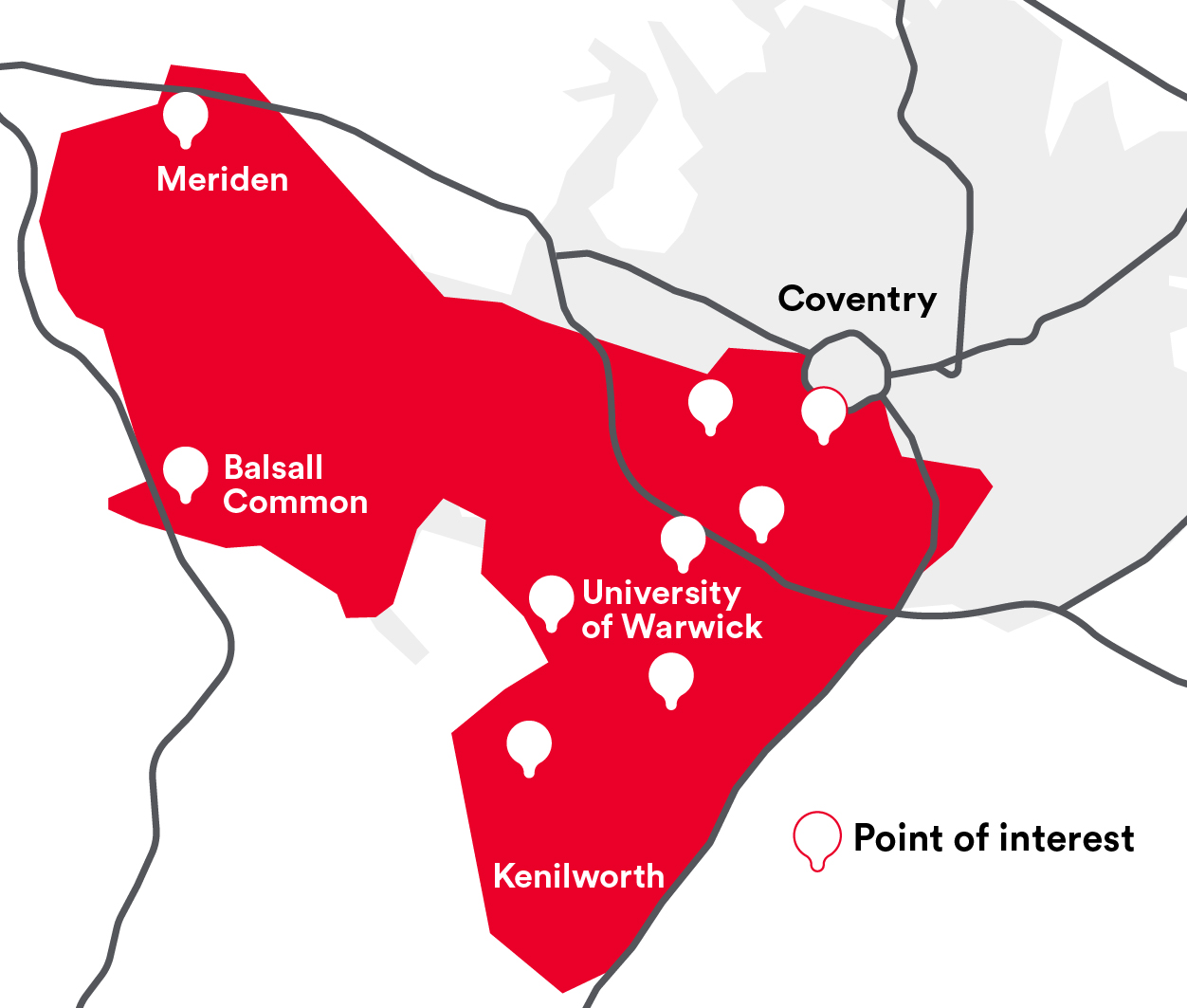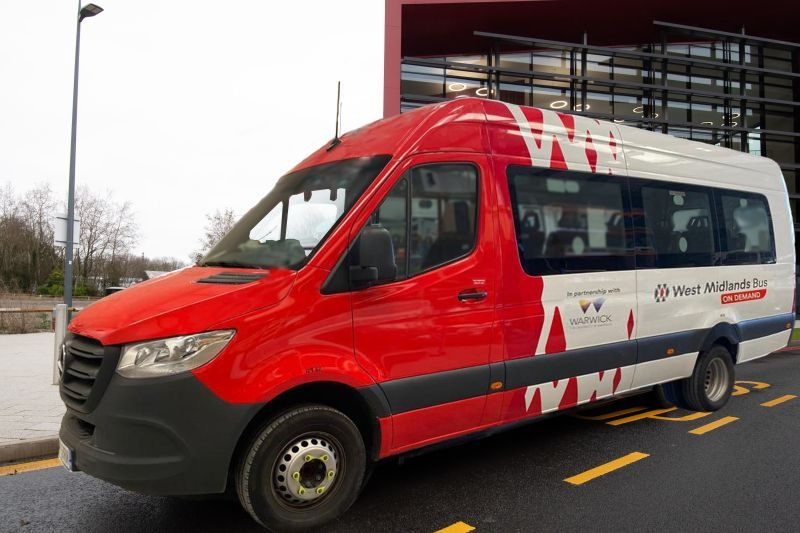An ongoing partnership between Transport for West Midlands (TfWM) and transport technology provider Via is helping people get where they need to go — without relying on private cars. The project, first launched in April 2021, established Bus On Demand, a Demand-Responsive Transport (DRT) bus system in and around the University of Warwick.
The service has been well-received so far, with hundreds of students and community members becoming early adopters and using it consistently. This article will explain why the scheme was introduced, what it means for both passengers and TfWM, and what insights it may yield for the further introduction of technology-powered transport throughout the United Kingdom.
What is demand-responsive transport, and how does it work?
Demand-responsive transport, also known as on-demand transport, is a form of transport that sits somewhere in between a traditional bus and a taxi. A DRT vehicle can have any capacity, from a small minivan up to the size of a traditional bus, and does not travel along a fixed route; instead, it adjusts its route and schedule dynamically to fulfill passenger trip requests. A DRT service may require passengers to walk to existing bus stops, or meet them at algorithmically-determined “virtual bus stops” (corners or other landmarks), or meet them directly at their requested pickup address.
In any service model, DRT is significantly more efficient, and more eco-friendly, than a private taxi service as it can aggregate multiple passengers travelling in the same direction. Moreover, it is convenient enough to get passengers out of privately-owned vehicles: in a DRT scheme in Sevenoaks, 73% of surveyed car-owning passengers reported using their car less and replacing these trips with dynamic demand-response journeys.
Versions of DRT have been implemented throughout the UK for decades, typically in the form of rural transport services in regions that could not support traditional fixed route transport, or community transport services for passengers with disabilities. These “dial-a-bus” schemes were, as the name implies, phone-based, with limited technology available to assist with optimising routes and schedules. As such, DRT had limited appeal to passengers, who had little flexibility for spontaneous trips, and transport agencies, who needed to take reservations and schedule and dispatch trips with paper manifests or by individual phone calls. These limitations kept DRT in fairly niche applications.
Within the last 5 years, as new technologies have emerged to automate booking, routing, and dispatch, DRT has grown in relevance to both passengers and transport operators. Schemes have proliferated throughout the UK (and the world), offering more flexibility — with trips booked truly “on-demand” by app, rather than hours or days in advance by phone — and significantly reducing the manual oversight required on the part of operators, transport authorities or local authorities. With these important changes, DRT has become a far more viable transport mode for both passengers, who experience greater convenience and quality of service, and transport operators, who require fewer resources.

Origins of the TfWM DRT scheme
Transport for West Midlands implemented Bus On Demand as part of a broader push for the use of transport technology (also known as “TransitTech”) in the region. The West Midlands were selected as the first of four UK Future Transport Zones, regions of the country designated to experiment with new transport technologies in an effort to reduce reliance on private cars and increase the sustainability of transport in the future. These Zones are expected to deliver data-driven insights to help inform transport policy for the rest of the country.
As an FTZ, the West Midlands were granted £22 million in funding in order to try several different approaches, including electric scooters, carshare, and DRT. Each new technology is intended to provide alternatives to private vehicles and reduce harmful emissions. The new DRT system is an attempt to try something relatively new in the UK — namely, to assess how DRT might work in a semi-urban region with a population that has access to multiple transport options. Critically, TfWM’s selected DRT technology connects passengers to conventional transport as well, integrating the new service into the broader network. The outcomes of this first project in the West Midlands could have a significant role in helping inform other DRT projects now being advanced by authorities around the UK. The National Bus Strategy, published earlier this year, attempts to reverse over a decade of declining bus ridership throughout the country and expressly includes DRT as an option to consider for small towns and rural regions, late night service, and Sunday service. Bus On Demand has the additional potential to demonstrate how DRT can complement existing fixed route services in denser regions.
While the origins of Bus On Demand were well in advance of the pandemic, COVID-19 and the impact it continues to have lend even greater urgency to the need to look for new ways to persuade people out of private cars and back into shared mobility. DRT aims to help ensure that the bus can be both compelling and cost-efficient.
How does the TfWM DRT scheme work? TfWM designed their service as an additional, dynamic transport option for university affiliates and community members alike. The service area not only accommodates trips between University of Warwick campuses, but several important commercial and transport hubs as well. Both the city centre and Coventry Railway Station are included in the service area, as are University Hospital, Pool Meadow Bus Station, and Leamington Spa. Moreover, the flexible nature of the underlying technology — the zone can be easily modified, as can the service hours and virtual bus stop logic — will allow TfWM to implement short-term service changes, like modified shuttle service during freshers’ week, and carefully test and phase in longer-term strategic updates.
The DRT scheme serves a number of distinct user groups, with a wide range of destinations and many other options for transport. In particular, the University of Warwick region was selected for the project because it is home to many young, educated people who may be especially open to new forms of transport, but also not dependent on any particular mode.
Passengers are able to plan their journeys by using the West Midlands Bus On Demand app, a white-labeled, Warwick-specific version of Via’s widely used Rider App. When they sign in to the app, they will be prompted to enter details about their journey. They will then be directed to a virtual “bus stop” where they can access the DRT bus for a shared trip. In the event that no on-demand journey can be arranged, Bus On Demand will suggest an alternative form of public transport which the passenger could use to reach their destination, ensuring that the DRT scheme functions as just one part of a thriving transport ecosystem. The app will provide all the details about that alternate transport, including the cost.
Implementation and reception of the demand-responsive transport project
The DRT system is run in partnership with Via, the UK’s most experienced DRT technology provider , and Coachscanner, a platform that tracks fluctuating demand levels in order to determine the need for vehicles and drivers. Together, these dynamic platforms provide the digital and physical infrastructure required to deliver flexible, on-demand trips throughout the University of Warwick region.
Just a few months into the on-demand transport trial, Bus On Demand is already proving to be a success. TfWM’s data show a high level of ridership since the April 2021 launch, with over 3,000 individuals signed up for the DRT app and a similar number of trips taken since. Individuals who try DRT tend to become regular passengers, indicating that the system is successfully meeting passengers' needs.
The typical engagement among registered users ranged from 4.9 trips per account to 6.5 trips per account, with the latter users tending to come from the 25% of passengers registered with university. The DRT service appears to be popular among university students and faculty, as 25% of passengers were registered with university email accounts. The remaining passengers were not necessarily directly affiliated with the university, but live and work in the area.
With this first Bus On Demand project underway, TfWM is now looking at further areas around the region where it can apply these learnings and expand the potential of this innovative form of bus delivery.




%206.png?width=71&height=47&name=The%20Buzz%20Blog%20Hero%20(1750%20x%201200%20px)%206.png)